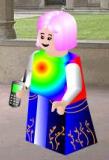IntroductionIn this chapter Carol Richardson will be discussing perspective and arguing that it was not just an Italian Renaissance development, but 'simply one illusionistic pictorial tool among many' (C.B.1 p.61).Constructing space in Renaissance Painting
Carol Richardson writes as above and argues that an over emphasis has been placed on the development of single point perspective during the 15thC linking it to the cultural identity of the times. She will proceed in asking just how significant this really was and how artists used it as part of the development of naturalism.
1) Depicting spatial relationships without single point perspective.
The example used for this section is Andrea Mantegna's The Agony in the Garden c.1460 (Plate2.2,p.65). In this painting there are no straight lines receding into the depth of the picture plane, but instead the artist depicts the spatial relationship by the size of the people and objects.
2) Brunelleschi's experiment and its impact
This is an important section explaining Brunelleschi's experiment and the impact this had particularly with the artists Donatello (Pl.2.5,p.68 Saint George and the Dragon c.1415-17) and Masaccio (Trinity c.1426 Pl.2.6,p.69). Lines of perspective are explained in diagrams which need to be looked at to fully appreciate the significance. However, the point is made that both Masaccio in displaying God and Piero della Francesca (Resurrection of Christ c.1465 Pl.2.10, p.72) show these main figures full frontal and not occupying the same dimensional space as the other characters, therefore emphasising their divine status.
3) Alberti teaches perspective
This is an important section on perspective, and highlights some of the theories that were held as to how the eye actually saw. There is an exploration of work by Uccello (Miracle of the Desecrated Host (The Selling of the Host) c.1465-9 Pl.2.14 p.76 and Saint George and the Dragon c.1470 Pl.2.15 p.77) Domenico Ve neziano (Saint Lucy altarpiece c.1444 Pl.2.16 p.78) and Piero della Francesca (Flagellation of Christ 1450-60 Pl.2.17 p.79) which highlights the use of perspective including tiled floors and architecture.
neziano (Saint Lucy altarpiece c.1444 Pl.2.16 p.78) and Piero della Francesca (Flagellation of Christ 1450-60 Pl.2.17 p.79) which highlights the use of perspective including tiled floors and architecture. 4) Fresco painting and the problem of multiple viewpoints
This section considers several examples of fresco paintings and how their artists have used perspective, the single vanishing point and the horizon line in an effort to place their figures in a convincing pictorial space, even though their paintings had to fit within difficult situations. For instance many frescos are painted high on the walls, well above the viewpoint of the actual viewer, but which must still be convincing enough to present that scene within a convincing space to that viewer. Often frescos were part of a cycle of pictures, which had to relate convincingly to each other. In a number of instances artists painted the light source in their fresco to match the true light source within the building adding to the pictorial reality and effect. The section features works from the Brancacci Chapel, Florence.
5. Perspective North of the Alps
This section deals mainly with the difference between the Italian use of the single vanishing point to achieve perspective, and the use by Northern artists of light, oil paint and aerial perspecive to create depth within the picture plane. There are several paintings which show the different methods employed as can be seen in works by Dieric Bouts (Pl.2.24 p.89, & Pl.2.25 p.90). Single point perspective does appear in Northern art in the work of Petrus Christus in the 1460's (Pl.2.30 p.96, Pl.2.31 p.97 & Pl.2.32 p.98) but Northern artists tended to give greater importance to picture detail and the effects achieved by oils. Dieric Bouts The Last Supper (Pl. 2.23 p.99.)is shown to be perspecivally correct but is still manipulated to show all the disciples and picture detail which tends to give the painting an odd view.
6. Conculsion
This suggests that the use of perspective was not a strict Renaissance development, but that it was a tool used by artists when applicable to achieve the objectives on their picture. It notes that Piero della Francesca's Flagellation (Pl.2.17 p.79) is really an exception in its subservient adherance to geometry and that within most works artists adapted perspective to suit their requirements.
 neziano (Saint Lucy altarpiece c.1444 Pl.2.16 p.78) and Piero della Francesca (Flagellation of Christ 1450-60 Pl.2.17 p.79) which highlights the use of perspective including tiled floors and architecture.
neziano (Saint Lucy altarpiece c.1444 Pl.2.16 p.78) and Piero della Francesca (Flagellation of Christ 1450-60 Pl.2.17 p.79) which highlights the use of perspective including tiled floors and architecture. 
No comments:
Post a Comment